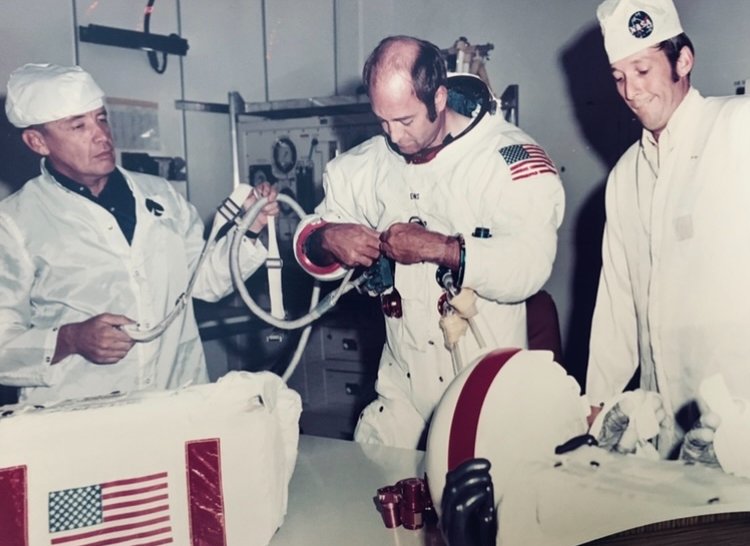NASA launch photo of Apollo 16. (photo right, top) Apollo 16 crew portrait. (photo right, bottom) Apollo 16 CSM "Casper" in lunar orbit. photo credist: NASA
APOLLO 16: Flown $2 Bill
Launch Date: April 16, 1972 | Splashdown Date: April 27, 1972
About the Provenance
This bill was acquired directly from Robert B. Horne. During the Apollo program, Bob was the Boeing Equipment Engineer assigned to the Johnson Space Center flight crew support team and was stationed at Kennedy Space Center. After assisting in the packing and stowing of the PPKs for the crew on Apollo 9, Bob personally was responsible for packing all of the lunar module and command module PPKs for all of the remaining Apollo Missions -- from Apollo 10 through Apollo 17. Bob listed, packed, stowed the individual astronauts' PPKs. This bill was a part of Bob's personal space collection since the flight of Apollo 16 until June 26, 2015, when this bill was formally acquired for the Jefferson Space Museum Collection. The bill is accompanied by letters of provenance from both Bob Horne, as well as from Apollo 16 LMP Charlie Duke, who has confirmed that the bill did, indeed, fly with the crew to the moon.
A rare photo of Bob Horne (left) with Apollo 17 command module pilot Ron Evans, and NASA suit technician Troy Stewart, during the EVA umbilical Crew Compartment Fit and Function in the suit room.
About the Bill
It was common practice during the Apollo program for the astronauts to take along a few personal items from key ground support crew personnel to thank them for their efforts and hard work during the mission. Given Bob's critical role with the astronauts' own personal PPK bags, they would often offer to carry items for him. On Apollo 16, the crew agreed to fly a few $2 bills -- 11 in all -- on behalf of a number of support crew. This bill, a series 1963, red seal note, with serial number A02317535A, was one of two consecutive serial number $2 bills taken by the crew on this mission for Bob. The bills, purchased at a local Cape bank by Bob's wife, were signed by the crew prior to launch, and were then officially inventoried on the crew's PPK list by serial number, and then packed with the rest of the crew's personal items and stowed aboard the space craft.
Apollo 16 was the tenth manned mission of Apollo, the fifth mission to land on the moon. It was also the first to land in the lunar highlands. The second of the so-called "J missions," Apollo 16 was crewed by Commander John Young, Lunar Module Pilot Charles Duke and Command Module Pilot Ken Mattingly. Launched from the Kennedy Space Center in Florida on April 16, 1972, the mission lasted a little over 11 days, before splashing back down in the Pacific on April 27, 1972.
Young and Duke spent 71 hours—just under three days—on the lunar surface, during which they conducted three EVAs (or moonwalks) totaling 20 hours and 14 minutes. On the lunar surface, Young and Duke collected 211 lbs of lunar rock and soil samples, while CMP Mattingly orbited the moon with this two dollar bill in the Command Module "Casper" performing photography and visual observations of the moon. In all, this bill (along with Mattingly) made 64 orbits of the moon during the length of the mission.
Apollo 16 Command Module "Casper" during one of its 64 orbits of the moon, as photographed from Apollo 16 lunar module "Orion." Aboard Casper, tucked carefully among the crew's PPKs, is this series 1963, red seal $2 bill, S/N A02317535A,
Credit: NASA/JSC Launch date: April 16,1972 Astronauts: John W. Young, Thomas K. Mattingly, and Charles M. Duke, Jr. Shows the landing and the three lunar traverses in the highland region of the Moon, near the crater Descartes.






